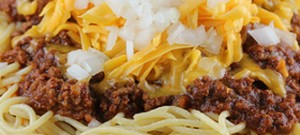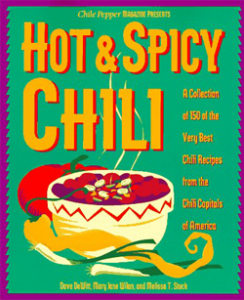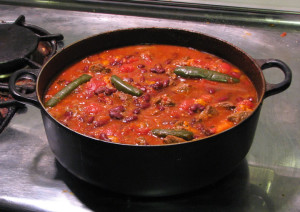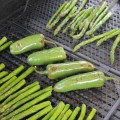Everything about chili con carne generates some sort of controversy—the spelling of the name, the origin and history of the dish, the proper ingredients for a great recipe, the awesome society and cookoff rivalries, and even what the future holds for the bowl o’ red. Perhaps the fiery nature of the dish itself is responsible for such controversy, driving usually rational men and women into frenzies when their conception of the truth is challenged.
As far as the spelling of the dish is concerned, etymologists tell us that there is enormous confusion about the terms that describe the Capsicums (chile peppers) and the recipes prepared with them. “For such a seemingly innocuous topic,” wrote Chile Pepper contributing editor Sharon Hudgins, “a confusion of terms abounds. Take your pick of spellings: chile(s), chili(s,es), chille(s), chilli(s,es), chillie(s), chilley(s), chilly(s,ies). Then take your pick of meanings: a fruit, a berry, a vegetable, a spice, a specific dish (with many variations) of pureed mild or pungent peppers, a specific dish (with many variations) of mild or pungent peppers with meat, or a specific dish (with even more variations) of meat with peppers (usually hot ones).”
Debates about the spelling are endless, and this controversy has even made it into The Congressional Record. Senator Pete Domenici (R-N.M.) noted in 1983: “New Mexicans know that ‘chili’ is that inedible mixture of watery tomato soup, dried gristle, half-cooked kidney beans, and a myriad of silly ingredients that is passed off as food in Texas and Oklahoma.” But at least Domenici allowed Texans to spell their chili with an i to differentiate it from the New Mexican versions of the dish.

Armadillo’s Breath chili team, from Central’s original series on chili.
love it.
For the past decade or so, some writers who must use these terms quite often, such as ourselves, have reached an informal agreement on style. To avoid confusing the plant and pod with the bowl o’ red, we use chile, the original Spanish-Mexican spelling, to refer to the plant and the pod. The word chili means the dish of meat and peppers. It is an abbreviated form of chili con came, which is a curious combination of the Anglicized chili (from chile) and the Spanish came (meat). Interestingly enough, some early California recipes were for came con chile, which is actually a more accurate description, in Spanish, of the chili of today.
Our style is not new. As early as 1949, Arthur and Bobbie Coleman, authors of The Texas Cookbook, noted: “The dish itself, the completed product, is chili with one ‘1’ and an ‘i’ on the end. . . . The word chile means a hot pepper, the fruit, not the powdered product. To spell the name of the dish chile would lead to confusing it with the main ingredients. …”
Another endlessly debated controversy is the origin of the bowl o’ red itself. Texans, New Mexicans, and Arizonans believe that the dish was invented in their state, and a chili historian, Bill Bridges, observed in The Great American Chili Book: “It has also been claimed that chili was invented by the army, the Texas Rangers, Confederate officers, American Indians, a Spanish nun, a Chinese chuckwagon cook, an Irish chuckwagon cook, Canary Islanders, Czechs, Greeks, Magyars, and the mountain people of the Caucasus.”
Archaeological evidence indicates that chile peppers— and their culinary use— evolved in South America and were domesticated there and in Mexico. But despite evidence that reveals dozens of recipes combining meat and chiles, most writers on the subject state flady that chili did not originate in Mexico.
Even Mexico disclaims chili; the Diccionario de Mejicanismos, a Mexican dictionary, defined it in 1959 as: “A detestable dish sold from Texas to New York City and erroneously described as Mexican.”
Despite such protestations, the combination of meat and chiles in stewlike concoctions appears frequently in Mexican cooking. Elizabeth Lambert Ortiz, in her book, The Complete Book of Mexican Cooking (1967), has a recipe for Chile con Carne made with ancho chiles, which she described as “an authentic northern Mexican style of cooking . . . as distinct from the version
that developed in Texas.” In The Food and Drink of Mexico (1964), George C. Booth commented: “In the United States, chili con carne is predominantly a bean dish, but in Mexico chile con carne is a generous meat dish.”
Mexican caldillos and pucheros (thick soups or stews), moles (sauces made with a variety of chiles), and ado bos (thick sauces) often resemble chili in both appearance and taste because they all sometimes use similar ingredients: various types of chiles combined with meat (usually beef), onions, garlic, cumin, and occasionally tomatoes. We have collected three such recipes from Mexico, Mole de Olla, Pork in Adobo Sauce, and Caldillo de Duranguense, to illustrate their fundamental similarity to chili.
There are even Texan chili purists who grudgingly—very grudgingly— admit a Mexican connection. As historian Charles Ramsdell noted, “It is true that in the northern part of Mexico, they serve what they call chile con came. It is stewed meat with a kind of salsa picante (hot sauce) poured over it. This, no doubt, is akin to our chili, in about the same degree as the Neanderthal man or the orang-outang is akin to us. It may be a remote ancestor. But it is not chili.”
Chili as we know it today may not have originated in Mexico, but it’s there now. Since 1978, the Mexican National Championship Chili Cookoff has been held in various locations in that country. The Mexican cookoff is sanctioned by the International Chili Society— proving that the love of chili is indeed international.
Chili con carne fanatics are not satisfied with a mundane theory holding that chili evolved from Mexican recipes. A strange tale about the possible origin of chili has appeared in several books, the first perhaps in George and Berthe Herter’s 1960 book, Bull Cook and Authentic Historical Recipes and Practices. The story of the “lady in blue” tells of Sister Mary of Agreda, a Spanish nun
in the early 1600s who never left her convent in Spain but nonetheless had out-of-body experiences during which her spirit was transported across the Atlantic to preach Christianity to the Indians. After one of the return trips, her spirit wrote down the first recipe for chili con carne, which the Indians gave her: chile peppers, venison, onions, and tomatoes.
Only slightly less fanciful is the theory that suggests that Canary Islanders, transplanted to San Antonio as early as 1731, used local peppers and wild onions combined with various meats to create early chili combinations. This theory, first advanced by H. Allen Smith, states that it was the Canary Islanders who first brought cumin— an essential spice in chili— to the United States.
Everett Lee DeGolyer, a scholar, chili aficionado, and multimillionaire, believed that Texas chili con carne had its origins as the “pemmican of the Southwest” in the late 1840s. According to DeGolyer, Texans pounded together dried beef, beef fat, chiltepins (in Texas, “chilipiquins”), and salt to make trail food for the long ride out to San Francisco and the gold fields. The concentrated, dried mixture was then boiled in pots along the trail as sort of an “instant chili.”
As Bill Bridges noted, “It seems obvious that chili would originate where there was an abundant supply of its two prime ingredients, meat and chile.” Bridges quoted from Mexican Gold Trail, the journal of George W. B. Evans, who in the mid-1800s mentioned a chili-like concoction. “Beef is prepared for the long journey by pounding it together with lard and pepper,” Evans wrote.
“A small pinch of this . . . thrown into a pan or kettle of boiling water with a little flour or corn meal for thickening, will satisfy the wants of six men at any time; and it is a dish much relished by all.” This reference may be one of the first written mentions of chili— albeit not by name. This pemmican premise even has a modern incarnation: brick chili, a highly fat-laden concoction that— because of a pound of suet— solidifies into a brick when it cools.
A variation on the pemmican theory holds that cowboys invented chile while driving cattle along the lengthy and lonely trails. Supposedly, range cooks would plant oregano, chiles, and onions among patches of mesquite to protect the ingredients from cattle. The next time they passed along the same trail, they would collect the spices, combine them with beef (what else?) and make a dish called “trail drive chili.”
According to another chili historian, Robert Stuart, large pots of this chili were stirred with a “chilistick,” which had absorbed the flavors and spiciness of the chili and therefore could not be used to stir any other food. A further variation on the cowboy theory holds that chili descended from “son-of-abitch stew,” a concoction made from the internal organs of a freshly killed calf
or deer.
Some chili scholars believe that the ex-chuckwagon cooks, who knew that trail drives would soon be a phenomenon of the past, opened up the first chili joints in cow towns along the trails. John Henderson, a western historian, described an early chili joint as “about twenty-five feet wide, half that in length, with a small space in the rear partitioned off to screen the cook stove and hide
the lack of sanitation.”
Joe Cooper noted that “during the late years of the previous century, almost every Texas town had its quota of restaurants which placed stress on chili. An unbelievable number were proprietored by guys named Joe. They guarded recipes with a passionate jealousy.”
Sam Pendergrast, the creator of “zen chili,” was weaned on cafe chilis. He recalled in Chile Pepper magazine: “In Abilene, where I grew up in the 1940s, the best chili cafes were the Green Frog near Fourth and Pine, the wonderfully exotic Canton Cafe further south on Pine, the Grape Inn at Tenth and Grape, and the Dixie Pig at South 14th and Butternut. They all served the same chili— blood red, with an aroma of cominos that could be whiffed at least a block away, hefty chunks of meat you could get your teeth into (along with bits of gristle), and a rich sauce featuring at least an eighth of an inch of grease that would easily soak up a quarter’s worth of crackers even at ’40s prices.”
The U.S. Army has often been given credit for originating chili, but these days that theory is generally discounted. According to chili scholar John Thorne, “Soldiers of the U.S. Army on the Western frontier had been eating chili since the war with Mexico (1846) but not necessarily in their messes. The first army publication to give a recipe for chili was published in 1896, the
Manual for Army Cooks (War Department Document #18). By World War I, the army had added garlic and beans; by World War II, tomatoes.”
Probably the most likely explanation for the origin of chili con carne in Texas combines the heritage of Mexican food with the rigors of life on the Texas frontier. Most historians agree that the earliest written description of chili came from J. C. Clopper, who lived near Houston. He wrote of visiting San Antonio in 1828: “When they (poor families o f San Antonio) have to pay for their meat in the market, a very little is made to suffice for the family; it is generally cut into a kind of hash with nearly as many peppers as there are pieces of meat—this is all stewed together.”
Except for this one quote, which does not mention the dish by name, historians of heat can find no documented evidence of chili in Texas before 1880. Around that time in San Antonio, a municipal market— El Mercado—was operating in Military Plaza. Historian Charles Ramsdell noted that “the first rickety chili stands” were set up in this marketplace, with the bowls of red sold by women who were called ‘chili queens.’
“The legendary chili queens,” continued Ramsdell, “ beautiful, bantering, but virtuous, made their first appearance. All night long they cooked, served, and flirted in the picturesque flare from hand-hammered tin lanterns, in the savory haze rising from clay vessels on charcoal braziers.”
Alexander Sweet, a San Antonio newspaper columnist, described Military Plaza and the chili stands in 1885: “He will see an array of tables and benches, and he will be assailed by the smell of something cooking. At the fire are numerous pots and kettles, around which are dusky, female figures, and faces that are suggestive of ‘the weird sisters’ whose culinary proclivities were such
a source of annoyance to MacBeth. These are the chile con carne stands, at which this toothsome viand is sold to all who have the money and inclination to patronize them.”
A bowl o’ red cost visitors like O. Henry and William Jennings Bryan a mere dime and was served with bread and a glass of water. O. Henry later wrote a short story about the chili stands entitled “The Enchanted Kiss.” In it, a young San Antonio drugstore clerk eats chili in the mercado and hallucinates (another out-of-body experience) that he is the former captain of the Spanish
army in Mexico who has remained immortal since 1519 by eating chili con carne! The alleged hallucinogenic (beer?) and life-lengthening properties (chile?) of chili are still much debated today at chili cookoffs.
Given the popularity of the dish, commercialization of it was inevitable. Somewhere between 1877 and 1882 (no chili historian seems to have figured this one out), William G. Tobin of San Antonio, Texas, produced (presumably in his home) the first canned chili, W.G. Tobin’s Chili-Con-Carne. By 1884, he had constructed and was about to open the first chili canning factory, the Tobin Canning Company in San Antonio, but he died, and the factory project failed. Incidentally, the first printed chili recipe appeared in Mrs. Owen’s Cook Book in 1880.
Chili became very popular in the Texas jail system between 1890 and 1900, giving some people the idea that the dish originated behind bars. Chili historian Floyd Cogan gives us the reason: “How else could you take bad or cheap cuts o f meat, add chile peppers, spices, and herbs and make them taste first rate?” According to Cogan, inmates rated the jails according to the chili that was served, and after serving their time they wrote back to the jails for recipes. “Some, we are told,” added Cogan, “missed it so bad that they committed crimes just to get back in jail so they could once again have their fill of real Texas jail chili.”
The fame of chili con carne began to spread, and the dish soon became a major tourist attraction, making its appearance in Mexican restaurants all over Texas— and elsewhere. At the World’s Fair in Chicago in 1893, a bowl o’ red was available at the “San Antonio Chili Stand.”
Around this time, commercial chili powder was created, but history is unclear about who actually invented it. Some chili historians credit the invention of the red dust to DeWitt Clinton Pendery of Fort Worth, who began selling his own brand of “ Chiltomaline” powder to cafes and hotels in the early 1890s. It was Pendery who noted in his advertising: “The health giving properties of hot chile peppers have no equal. They give tone to the alimentary canal, regulating the functions, giving a natural appetite, and promoting healthy action of the kidneys, skin, and lymphatics.” Pendery’s company, first called The Mexican Chilley Supply Company, later changed its name to Pendery’s, and it’s still open and selling chili powder (and many other spices) today in Fort Worth.
Other sources insist that it was William Gebhardt of New Braunfels, Texas, who produced the first packaged chili powder in 1894. Two years before, Gebhardt had opened a cafe in back of Miller’s Saloon and discovered that chili was the favorite food of his customers. But chili was a seasonal food because homegrown chiles were available only after the summer harvest. Gebhardt solved the problem by importing Mexican ancho chiles so that he could serve the dish year-round.
At first, Gebhardt ran the chiles three times through a home meat grinder. Later, according to a description of the time, Gebhardt “concocted a chili powder in a crude mill by grinding chile peppers, cumin seed, oregano, and black pepper through an old hammer mill, feeding a little of this and a little of that to the mill. What came out was put in little-necked bottles and then
packed in a box for retail.” At first he called the product “Tampico Dust,” but he later changed the name to “Gebhardt’s Eagle Chili Powder.”
In 1896, Gebhardt opened a factory in San Antonio and was producing five cases of chili powder a week, wliich he sold from the back of his wagon as he drove through town. He was also an inventor, and eventually patented thirty-seven machines for his factory. By 1899, Gebhardt had received U.S. trademark number 32,329 for his Eagle Chili Powder. The Gebhardt brand is still in existence today.
The turn of the century witnessed a surge in the popularity of chili. Hodge Chili was canned in St. Louis, Missouri, in 1905, and in 1908, Ike’s Chili House opened in Tulsa, Oklahoma. That establishment is still open at 712 South Boston Street. Lou Priebe, a regular customer there (and also a judge at the Blue Grass Chili Festival) commented on the establishment: “Chili was the ‘soul food’ of the Okies. During the Depression you could go into Ike’s and get a bowl of chili for a quarter, and it was the main meal of the day.”
William Gebhardt’s own brand of chili was canned in San Antonio in 1908 (some say 1911), and “chile con carne” was first defined in an American dictionary in 1909, according to Joe Cooper. It was “a Mexican dish consisting of minced red peppers and meat.” Another definition (not in a dictionary) referred to the bowl o’ red as “the devil’s soup,” an allusion to the hot chiles in it.
By 1917, Walker’s Red Hot Chile con Carne was being canned in Austin, Texas— note the e in chile. During the following year, Walker’s was producing forty-five thousand cans of chili a day. In 1921, Wolf Brand Chili was being canned in Corsicana, Texas.

About this time, the popularity of the bowl o’ red began to spread, and the first chili emporium opened in Cincinnati in 1922 (some say 1923), the Empress Chili Parlor. According to chili historian F. Starr, “ Cincinnati chili was concocted in October, 1922, by a man who had never eaten a bit of Texas chili, and it has been made ever since by people immunized against it by geography
and culture.”
Indeed. The easterners began serving the chili in strange ways, which, of course, forever earned them the scorn of Texans. One-Way chili was straight, Cincinnati-style chili. Two-Way was served with spaghetti under the chili. Three-Way added cheese on top. Four-Way added onions to the spaghettiand-cheese chili, and Five-Way added beans to the spaghetti base!
Back in Texas, the chili queens were banned from selling in San Antonio in 1937 for health reasons— public officials objected to flies and poorly washed dishes. They were restored by Mayor Maury Maverick (a real name, folks—unbranded cattle were named after his dad) in 1939, but their stands were closed again shordy after the start of World War II.
Chili continued to be mentioned occasionally— and erroneously— as late as 1964, when William I. Kaufman, in his book Recipes from the Caribbean and Latin America, wrote in his recipe for Fiesta Chili con Carne: “The best known of all Mexican dishes, chili con carne, may also be eaten with rice instead of beans.”
The Texans, however, never forgot their culinary heritage, and in 1977 the Texas Legislature proclaimed chili con carne to be the “Official Texas State Dish.” Incidentally, in 1993, the Illinois State Senate passed a resolution proclaiming that Illinois was to be the “ Chilli [sic] Capital of the Civilized World,” a move that outraged Texans.
During the 1980s, San Antonio began staging what they call “historic reenactments” o f the chili queens, complete with some of the original queens, such as songstress Lydia Mendoza, who serenade the chili eaters. The “Return of the Chili Queens Festival,” held each year in Market Square, recreates the era of the chili queens and celebrates the dish that, no matter what its origin, will live forever in the hearts, minds, and stomachs of Texans.

Editor’s Note: This is just the tip of the chili iceberg. Find out more in Dave DeWitt’s Hot & Spicy Chili, which you can pick up here.
Latest posts by Mark Masker (see all)
- 2024 Scovie Awards Call for Entries - 07/07/2023
- 2024 Scovie Awards Early Bird Special: 3 Days Left - 06/29/2023
- 2024 Scovie Awards Early Bird Deadline Looms - 06/25/2023









